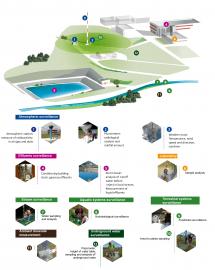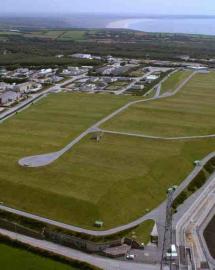Focus on.... Environnemental surveillance
Environmental monitoring: before, during and after operations
Andra's centers have been designed to protect humans and their environment from the risks associated with the radioactivity contained in the stored waste. A comprehensive and rigorous monitoring system is in place to ensure that the impact of these facilities is kept at the minimum. It starts long before the facility is built, and may extend centuries after it's closed...
Each year, thousands of measurements and samples (water, air, plants, etc.) are carried out on and around the Aube and Manche storage centers. All the results of these measurements and their analysis are communicated in the annual reports, during presentations to the local information committees of the centers, and are published on the site of the radioactivity measurement network published by ASN and the 'IRSN.
In the Meuse and Haute-marne districts, the objective of the Perennial Environment Observatory (OPE) is to make an initial state of the environment before Cigéo, the Deep Geologgical repository, is built and operated, and to follow its evolution over the next century . It is unique in France because it is the first observatory to simultaneously study all the compartments of the environment of a vast study area.
Why monitor?
Monitoring the environment around our facilities is a responsible attitude which consists not only of doing whatever is required to make sure we have the least possible impact on humans and the environment, but also to confirmed, through monitoring and regular measurements, that this is indeed the case,
It is also a duty towards the territories that welcome us to inform them about how our facilities operate and to report the results of this monitoring.
Regulatory context
Industrial site monitoring in France is regulated by the Code of the environment, which notably regulates releases authorizations. This includes various regulatory laws applicable to basic nuclear installations (BNI) or installations classified for the protection of the environment (ICPE). The Manche disposa lfacility (CSM) and the Aube storage facility (CSA) are BNIs, while the CIRES is an ICPE. The operation of these different sites requires a authorization from the authorities, and rigorous monitoring of their impact on the environment.
Ministerial decrees set the general requirements relating to the limits of releases(gaseous and liquid) and define the sampling requirements.
A specific authorization is issued for each installation by the prefecture or the minister, based on the impact assessment submitted by the operator in its operating license application file.
This authorization specifies the various elements to be monitored and fixes for each of them them an annual releases limit. The operator then establishes an environmental monitoring plan in accordance with its authorization, which describes the monitoring methods and establishes a detailed program of measures (the quality of air, surface water, groundwater, to which are added, for BNIs, radiological samples from the natural environment). Monitoring results are then regularly sent to the supervisory authorities via regular reporting and an annual review report.
Informing the public
All the results of the monitoring of Andra Centers are the subject of regular publications and presentations to the Centers' local information commissions. They are also accessible directly on the Internet, in particular via the site of the National Radioactivity Measurement Network of the environment (RNM) under the aegis of ASN and managed by IRSN.
Monitoring disposal facilities
Andra carries out its missions with a permanent concern for the protection of people and the environment. Thus, regular checks are carried out on effluents (gas, solids and liquids) and work areas. Three levels of environmental monitoring are in place: radiological monitoring, physico-chemical monitoring and ecological monitoring. The results of these analyzes are compared with those obtained before the storage centers are put into service to verify the absence of environmental impact.
Monitoring the CSA and the CIRES: monitoring during operations
The Andra centers in Aube and their environment are subject to regular and detailed monitoring. The environmental monitoring rules are defined in the operating authorization order of June 26, 2003 for Cires and in the creation authorization decree of September 4, 1989 for the CSA. The monitoring system is based on a set of measures to:
- verify compliance with regulatory requirements;
- ensure compliance with the requirements issued by the Nuclear Safety Authority, in particular the technical requirements;
- detect any abnormal situation or development;
- define, if necessary, new provisions to prevent the recurrence of the abnormal situation.
Each year, nearly 15,000 analyzes are carried out on different elements of the environment around and inside the centers: air, groundwater, rain and streams, sediments, the food chain ...
All the results of the surveillance of Andra's industrial centers in Aube are the subject of regular publications and presentations to the local CSA information committee and to the Cires site monitoring committee.
In accordance with the Environmental Code, Andra publishes a detailed activity report for the CSA each year, which includes the main results of site monitoring. An identical report is produced annually for Cires.
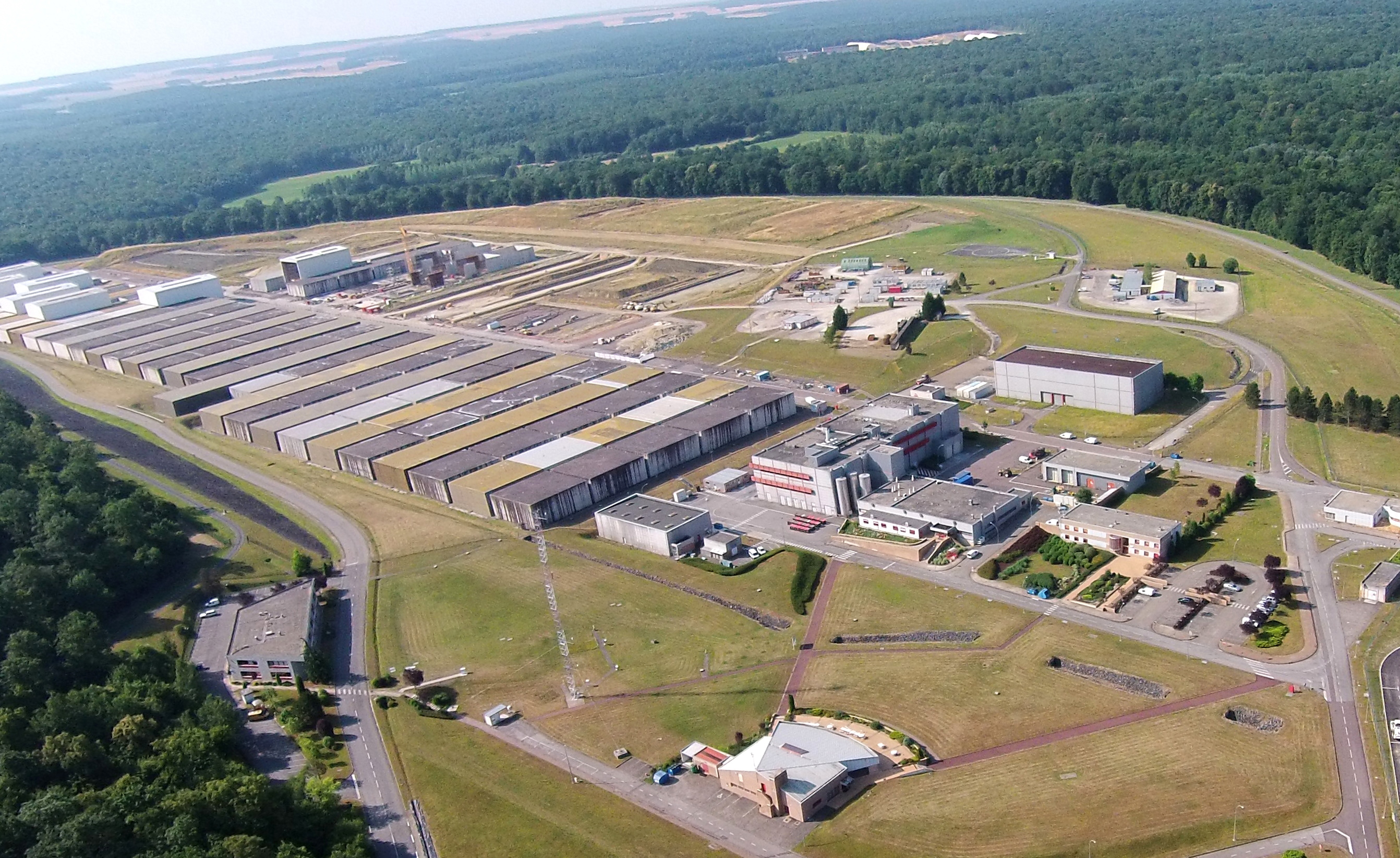
Each year
samples taken in the environment
radiological measurements at the CSA
radiological measurements at the CIRES
The CSA radiological impact
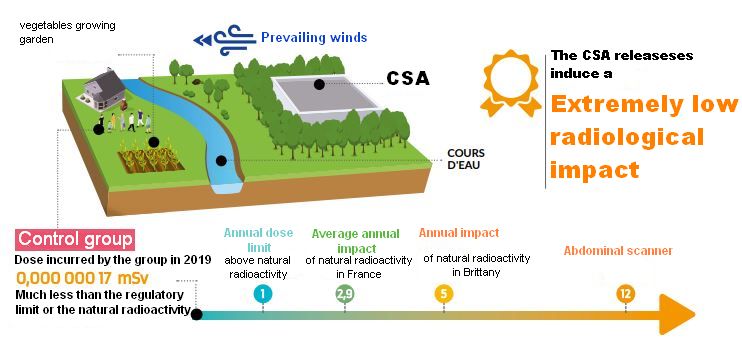
The environment controlled by independent commissions
The local information commission of the Aube repository has the possibility of commissioning independent appraisals or analyzes of the site environment in order to prepare its own information for the population. On several occasions, it has mandated Acro (NGO for the control of radioactivity to carry out sampling and analysis campaigns around and within the CSA. During these campaigns, the results obtained are compared with those of Andra.
The Cires Site Monitoring Commission (CSS) can also conduct its own analyzes to monitor the centre's environment.
Results are accessible to everyone
All the results of the monitoring of Andra facilities are also accessible directly on the Internet, in particular via the site of the National Radioactivity Measurement Network of the environment (RNM) under the aegis of ASN (safety authority) and managed by IRSN (ASN technical support organization).
As required by the law of June 13, 2006 on to transparency and security in nuclear, known as the TSN law, Andra publishes each year a detailed activity report for each
of its facilities, which includes the results of the monitoring of the site concerned. These reports are accessible directly on the site of the agency.
The RNM centralizes the results of measurements of radioactivity in the environment produced by various producers, including Andra, throughout France. The RNM
gathers the information of the measurements carried out on samples and measurements of automatic stations, such as our some 300 sensors placed throughout the
territory,
Andra, as part of its regulatory obligations, transmits to the RNM each months the results of the monitoring of its sites. Once validated, environmental data can be consulted on the www.mesure-radioactivite.fr portal. ”
The site, both technical and educational, is for to all audiences (authorities, experts, general public).
Monitoring the Centre de la Manche (CSM): post-operational monitoring
The Manche repository has not received any radioactive waste since 1994, when it reached its full capacity of over 600,00m3. Today the facility's activity consists mainly of monitoring the evolution of the repository, checking that its behavior is in accordance with forecasts and that its impact on its environment. remains very low.
The objectives of the surveillance carried out at the Manche repository are to:
- Check compliance with regulatory requirements,
- Evaluate the impact of the centre's activities on its environment,
- Detect any situation and / or abnormal development,
- Ensure that the installations are maintained in an operational state, in compliance with regulatory requirements and using the best available techniques,
- Repair or consolidate installations as needed.
Around 2,000 samples and 10,000 analyzes are carried out each year on and around the Manche repository. Their frequency is variable: it can be daily, monthly or quarterly.
How is the impact of the CSM evaluated?
Andra is evaluating the impact of its releases on the population based on measurements taken, among others, in the Sainte-Hélène stream and on the basis of a sample of the population called the "reference group". A calculation is carried out according to the following principle: it is imagined an inhabitant (adult man) of the hamlet of La Fosse, in Digulleville, who would consume only food produced in the hamlet (meat, dairy products, eggs, vegetables and fruits) and would drink only Saint Helena water. Thus, the impact due to the presence of tritium, that is to say the dose received over the year by this man, would be of the order of 0.00018 millisievert, or approximately 10,000 times lower than the limit. exposure regulations recommended for the public (1 millisievert per year).
Water monitoring
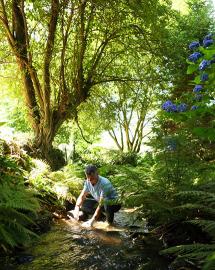
radiological and chemical
checks in the Sainte-Hélène
stream
Rainwater is channeled and directed to a measuring chamber where it is controlled and then sent to a storm basin located on the nearby Orano site. This water then joins the rainwater network of Orano to be discharged, after control, to the stream of Sainte Hélène.Drainage water, collected by the collection network located under the storage structures, is channeled and directed to a dedicated measuring chamber. These waters are checked before being released to Orano. They then join their water network intended to be discharged into the sea.
Andra also monitors and analyzes three streams that may be affected by the facility's activities: Sainte-Hélène, Grand Bel and Les Roteures.
Regarding groundwater, it is monitored through samples taken in the 60 piezometers present in the Center and at the periphery of the disposal structures. This monitoring is supplemented by 13 other piezometers belonging to the Orano site in La Hague.
Air monitoring
The Manche storage center is equipped with various equipment for controlling air quality.
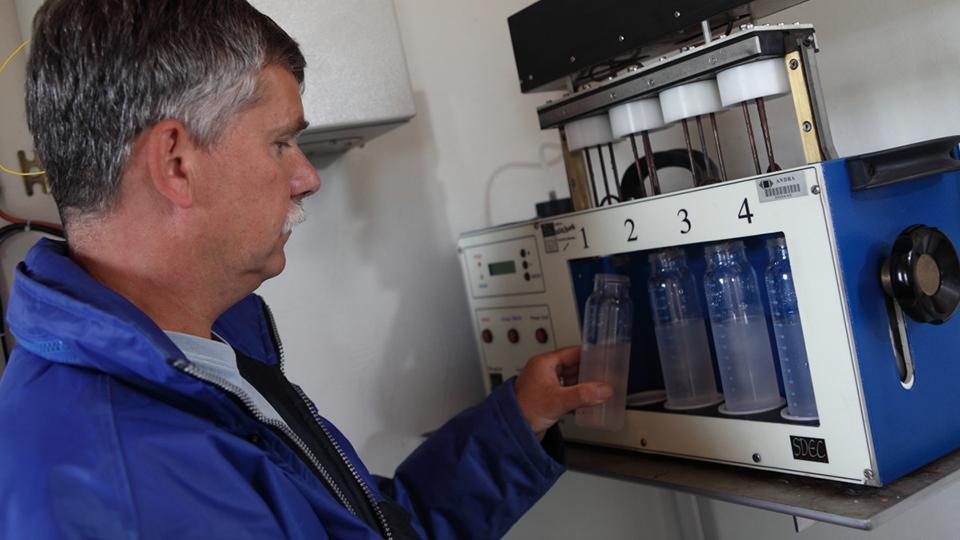
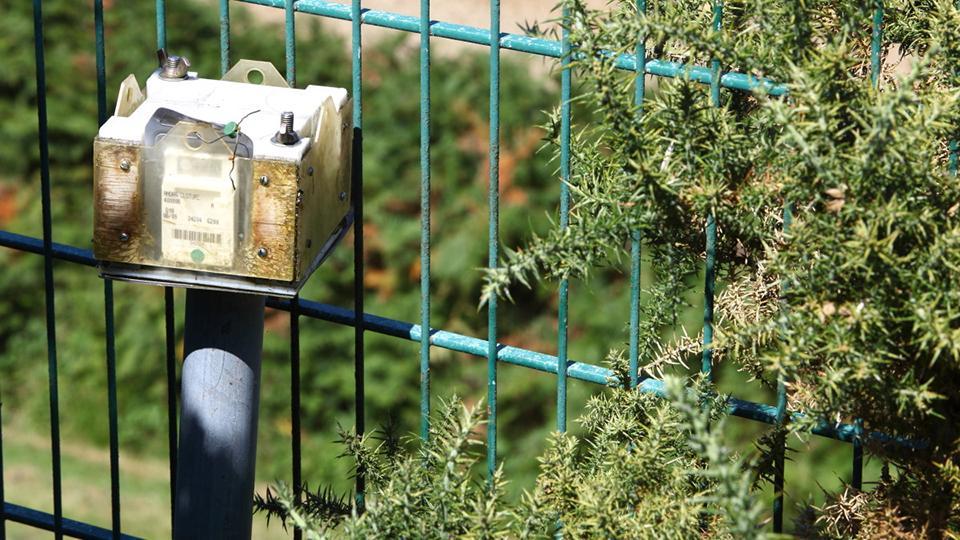
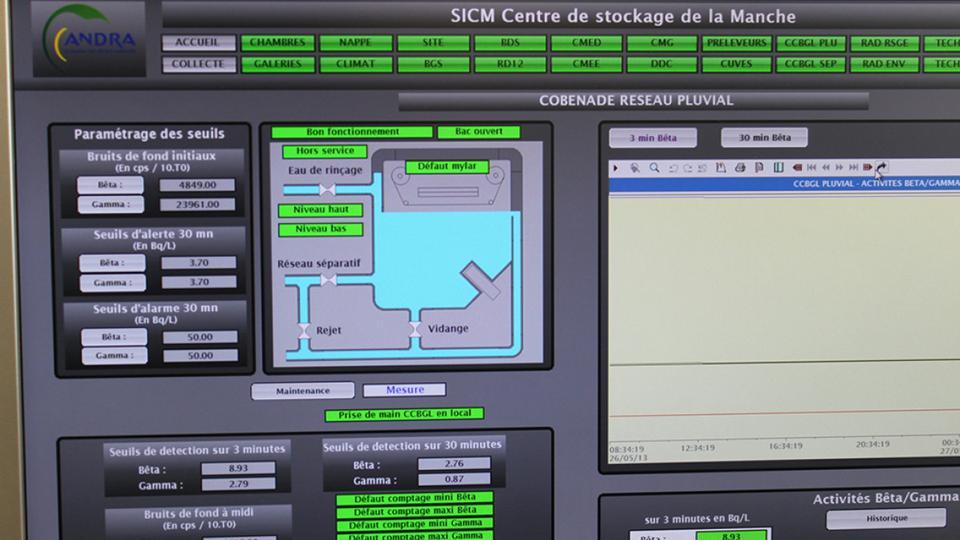
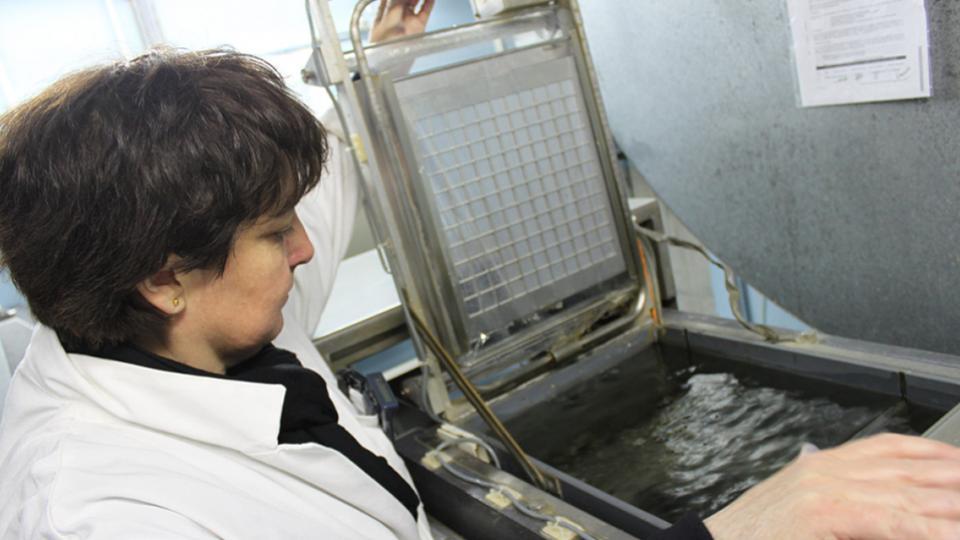
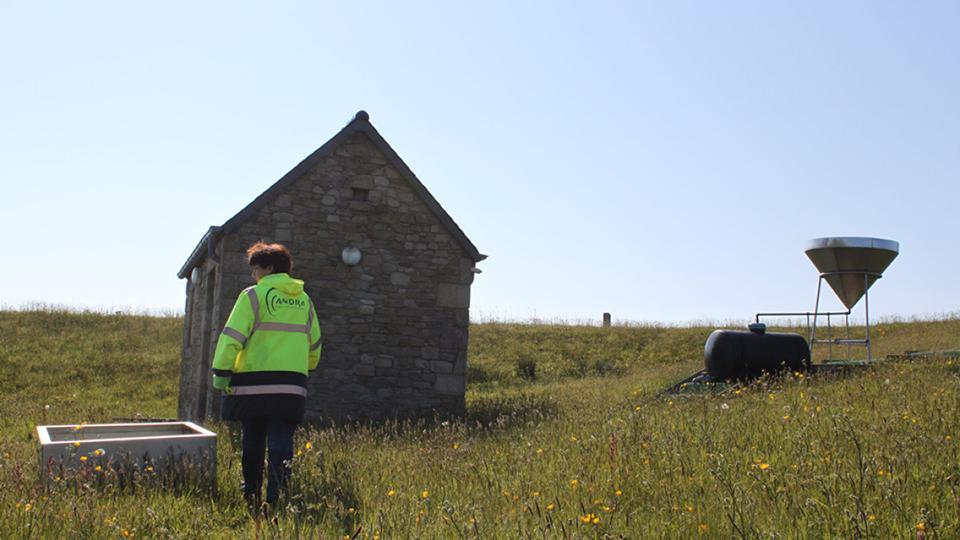
Measurements and results
Around 2,000 samples and 10,000 analyzes are carried out each year by Andra on and around the Manche repository.
These measures consist of monitoring the possible presence of radioactivity and chemical elements in order to verify the impact of the repository on the natural environment.
The analyzes are carried out by laboratories approved by the Nuclear Safety Authority (ASN), including the laboratory at the Andra in Aube repository (CSA).
The results of these measurements are sent to the Nuclear Safety Authority (ASN), presented at a meeting of the Local Information Commission (CLI) and accessible to the general public in the annual information reports published by the CSM and on the site of the national environmental radioactivity measurement network, site published by ASN and IRSN
Tritium average activity in 2016 measured in the piezometers.
This value is down from 7230Bq/l in 2004
The impact of the CSM is 1/1000th of the natural radioactivity


